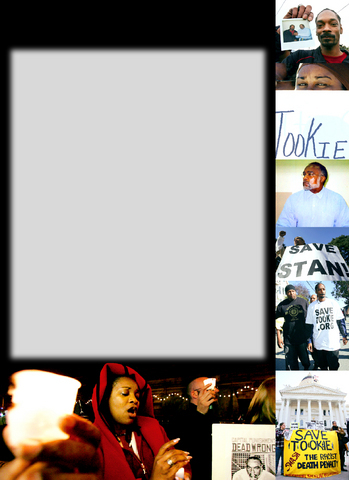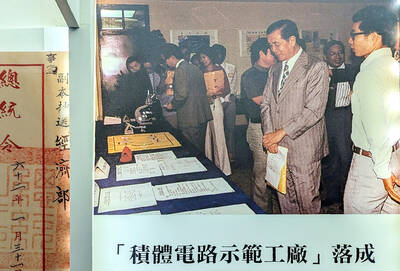Punkin McNair will try anything to warn his students at Bell Gardens High School away from gangs, and the story of Stanley Tookie Williams provides the perfect vehicle.
McNair built a curriculum for his English class based on the books written by Williams, widely reputed to be a founding member of the notorious Crips street gang, who is scheduled to die by lethal injection on Tuesday for murdering four people in 1979. The nine-book series, titled Tookie Speaks Out Against Gangs, won Williams widespread praise and
literary awards, including nominations for both the Nobel Peace Prize and the Nobel Prize for Literature.

"Here's somebody that's true-to-life from the 'hood,'" McNair said. "He's from similar streets that we've walked today. And look at what he's done. That lets you know that it's never too late."
Less than 30km away, Larry Sabala of Torrance is still haunted by images of the shotgun slayings he saw while sitting on the jury that convicted Williams of the murder of convenience-store worker Albert Owens, 26, and motel owners Yang Yen-I, 76, and Yang Tsai-shai, 63, and their daughter Lin Yee-chen, 43, during separate robberies.
Sabala, 63, and his fellow jurors recommended the death penalty, and now nearly 25 years later he still believes

Williams deserves to die.
"What do you think it looks like when you've been shot at close range with a 12-gauge shotgun? It's not pretty," he said.
These are the two lives of Tookie
Williams, whose impending execution has ignited a firestorm of debate around the nation about the death penalty in general, and in particular whether Williams should be granted clemency.
Death penalty opponents and gang members have united to fight for Williams' life, touting his role as a teacher and a mentor trying to steer children away from gangs and violence.
They've formed the Save Tookie Committee, staging rallies attended by the likes of the Reverend Jesse Jackson, Snoop Dogg and Jamie Foxx, who played Williams in a movie about his life.
The National Association for the Advancement of Colored People held a Save Tookie Williams Tour on Tuesday, featuring press conferences and rallies in Los Angeles, San Francisco, Sacramento and San Diego. More than 30,000 people have signed a Save Tookie petition at his Web site, www.tookie.com.
But others maintain he's an unrepentant career criminal whose refusal to apologize for the murders -- or even acknowledge his participation in the execution-style slayings -- demonstrates his inhumanity and bolsters the arguments for his
execution.
Check facts
With all of Williams' legal appeals exhausted, his fate lies with Governor Arnold Schwarz-enegger. The governor had scheduled closed-door meetings last week when Williams' attorneys argued that his behavior behind bars makes up for his life of violence on the streets of Los Angeles.
Stanley Tookie Williams III was born Dec. 29, 1953, in Shreveport, Louisiana. He was named for his father -- Tookie is his given middle name, not a nickname -- but raised by his mother, who gave birth to him when she was 17.
In an effort to escape the poverty and crime in Louisiana, his mother moved to California in 1959, settling in South Los Angeles.
In his popular memoir, Blue Rage, Black Redemption, Williams said kids needed a fight-or-flight mentality to survive the streets of South LA. He chose to fight, and did often.
"I felt trapped," he wrote in the book, which is on four-week back order on Amazon.com. "My mother's attempts to rescue us from a disordered society caused us to jump out of one fire into a vhotter one."
After several stints in juvenile hall, Williams joined a gang in the early 1970s, while a 17-year-old student at Washington High School.
Details of the early years of the Crips are hazy, but some experts dispute reports that Williams was a co-founder of the notorious gang. However, there has never been any question he was an influential early member of the Crips as well as right-hand man to Raymond Washington, the gang's leader.
John Quicker, a professor at California State University, Dominguez Hills, said Williams was introduced to the Crips in 1971 or 1972, after watching a schoolyard argument between a lone classmate and a group of several other students. Impressed with his classmate's fearlessness, Williams told him he would have taken his side if a fight had erupted, Quicker said.
"The person said, `Don't worry about it, I can take care of it,"' said Quicker, a gang expert who has interviewed several members of the early Crips.
"The next day, this person came back with Raymond and the boys and a whole bunch of Crips and put it to the gang that gave him the hassle in the first place. Tookie was so impressed with the power demonstrated by Raymond and the fledgling Crips that he threw his towel in with Raymond."
Williams and Washington became fast friends, and Williams quickly built a reputation on the street for his toughness, fearlessness and charisma.
He spent time lifting weights at Venice Beach, often going shirtless to show off his powerful build. To look even more menacing, Williams and other Crips would often walk around with Doberman Psinschers.
The Crips emerged in the 1970s as a dominant gang in Los Angeles. As guns became more easily available -- especially after the Vietnam War, when many soldiers returned with weapons -- the level of gang violence escalated.
"With more guns, there's more shooting, there's more killing and there's more retaliation," said Malcolm Klein, a USC professor and gang expert.
On Feb. 28, 1979, Albert Owens was slain during a robbery at a 7-Eleven store in Pico Rivera where he was a clerk. Owens was taken into a back room, forced to lie down and shot twice in the back with a shotgun. The robbery netted about US$120.
Yangs and Crips
On March 11, 1979, the Yangs were killed during the robbery of the Brookhaven Motel on South Vermont Avenue -- a crime that netted the robber about US$100. Like the robbery two weeks earlier, the family members were shot at close range with a shotgun.
Although no physical evidence directly linked Williams to the killings, police arrested him soon after and built a case against him based on eyewitness' testimony and circumstantial evidence.
Williams and his supporters argue that the bulk of the testimony used to convict him came from questionable sources -- jailhouse informants and criminals looking for leniency.
But Sabala said he and his fellow jurors had no trouble reaching a verdict. They convicted Williams in 1981 of four counts of murder with special circumstances and recommended the death penalty, a decision affirmed by the trial judge. Every state and federal court up to the US Supreme Court has upheld the conviction.
"It was quite obvious he was guilty," Sabala said. "It wasn't even close. To have eyewitnesses to the actual murder, one of the participants, plus they have the gun involved in it and they matched the shells, that was quite obvious."
Sabala still remembers the gruesome images from the crime-scene photographs, bodies lying in the blood-spattered motel room, Lin shot in the face.
"I'd love to sit in at his execution," Sabala said. "I'd even go so far as to push both plungers and put the liquid into his veins."
During his first 12 years on San Quentin's Death Row, Williams remained the violent gangster he had been on the streets of LA.
Prosecutors and prison officials said he beat other inmates, attacked guards and led the Crips gang that operated inside the prison. In 1988, after prison officials believed he ordered the stabbing of another inmate, he was placed in a small cell commonly known as "The Hole."
epiphany
There, he had an epiphany.
"I think he hit rock bottom," said Phil Gasper, a death penalty opponent and professor at Notre Dame de Namur Uni-versity who befriended Williams about five years ago. "That isolation, he had nowhere to go and nothing much to think about except his own life."
It was at this point, supporters say, that Williams renounced his gang lifestyle and dedicated his life to spreading an anti-gang message.
The best way to do it, he thought, was through children's books.
He told this plan to Barbara Becnel, a journalist who'd interviewed him at San Quentin in 1992 for a book on gangs. Becnel was initially suspicious, but she encouraged him to pursue his idea.
In 1993, Williams offered to try to help broker a peace between the Crips and their fiercest street rivals, the Bloods.
He videotaped a message at San Quentin that was shown to a group of 400 gang members at a summit in Watts in April 1993. With Williams' help, the truce was reached, and by 1996 authorities reported a 25
percent drop in gang-related homicides in Los Angeles County.
Becnel said, "When I saw his voice was a respected voice, I thought, this is of value, and I need to do whatever I can."
Over the next three years, Becnel and Williams teamed up to write eight children's books, all of which were published in 1996, including Gangs and Violence, Gangs and the Abuse of Power, Gangs and Weapons and Gangs and Drugs.
Because of the books, Williams has been nominated for the Nobel Peace Prize five times and the Nobel Prize for Literature once. Gasper submitted four of the nominations for the Peace Prize.
"His influence has been so positive in the last 10 to 12 years, he's worthy of being nominated," Gasper said. "I know quite a few Death Row inmates, but I've never met anyone with the dedication and determination that Stan has."
Gang experts are mixed over the impact of Williams' work.
The case went to appeal and the verdict was upheld. Now, only Schwarzenegger can prevent Williams' execution. Lawyers for Williams pleaded for his life before Schwarzenegger on Thursday, five days before Williams is set to die.
"I want to make sure I make the right decision," Schwarzenegger has said. "We are dealing with a person's life."
With supporters and opponents entering the last stretch in the battle to see justice done, Stanley Tookie Williams' case divides moral opinion.

Oct. 27 to Nov. 2 Over a breakfast of soymilk and fried dough costing less than NT$400, seven officials and engineers agreed on a NT$400 million plan — unaware that it would mark the beginning of Taiwan’s semiconductor empire. It was a cold February morning in 1974. Gathered at the unassuming shop were Economics minister Sun Yun-hsuan (孫運璿), director-general of Transportation and Communications Kao Yu-shu (高玉樹), Industrial Technology Research Institute (ITRI) president Wang Chao-chen (王兆振), Telecommunications Laboratories director Kang Pao-huang (康寶煌), Executive Yuan secretary-general Fei Hua (費驊), director-general of Telecommunications Fang Hsien-chi (方賢齊) and Radio Corporation of America (RCA) Laboratories director Pan
The consensus on the Chinese Nationalist Party (KMT) chair race is that Cheng Li-wun (鄭麗文) ran a populist, ideological back-to-basics campaign and soundly defeated former Taipei mayor Hau Lung-bin (郝龍斌), the candidate backed by the big institutional players. Cheng tapped into a wave of popular enthusiasm within the KMT, while the institutional players’ get-out-the-vote abilities fell flat, suggesting their power has weakened significantly. Yet, a closer look at the race paints a more complicated picture, raising questions about some analysts’ conclusions, including my own. TURNOUT Here is a surprising statistic: Turnout was 130,678, or 39.46 percent of the 331,145 eligible party

The classic warmth of a good old-fashioned izakaya beckons you in, all cozy nooks and dark wood finishes, as tables order a third round and waiters sling tapas-sized bites and assorted — sometimes unidentifiable — skewered meats. But there’s a romantic hush about this Ximending (西門町) hotspot, with cocktails savored, plating elegant and never rushed and daters and diners lit by candlelight and chandelier. Each chair is mismatched and the assorted tables appear to be the fanciest picks from a nearby flea market. A naked sewing mannequin stands in a dimly lit corner, adorned with antique mirrors and draped foliage

The election of Cheng Li-wun (鄭麗文) as chair of the Chinese Nationalist Party (KMT) marked a triumphant return of pride in the “Chinese” in the party name. Cheng wants Taiwanese to be proud to call themselves Chinese again. The unambiguous winner was a return to the KMT ideology that formed in the early 2000s under then chairman Lien Chan (連戰) and president Ma Ying-jeou (馬英九) put into practice as far as he could, until ultimately thwarted by hundreds of thousands of protestors thronging the streets in what became known as the Sunflower movement in 2014. Cheng is an unambiguous Chinese ethnonationalist,